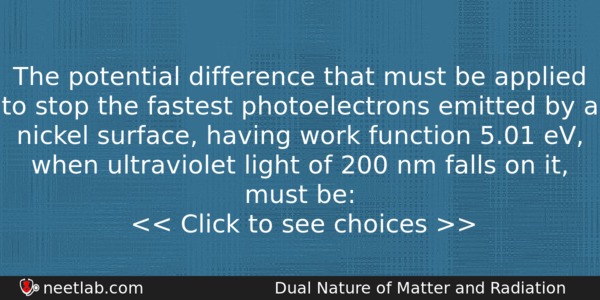| ⇦ | 
| ⇨ |
The potential difference that must be applied to stop the fastest photoelectrons emitted by a nickel surface, having work function 5.01 eV, when ultraviolet light of 200 nm falls on it, must be:
Options
(a) 2.4 V
(b) – 1.2 V
(c) – 2.4 V
(d) 1.2 V
Correct Answer:
1.2 V
Explanation:
Kₘₐₓ = hc / – W = hc / λ – 5.01
= 12375 / λ(in Å) – 5.01
12375 / 2000 – 5.01 = 6.1875 – 5.01 = 1.17775
= 1.2 V
Related Questions: - A car is moving with uniform acceleration. It covers 200 m in 2 sec and 220 m
- A coil has resistance 30 ohm and inductive reactance 20 ohmn at 50 Hz frequency.
- The molar specific heats of an ideal gas at constant pressure and volume are denoted
- The half life of a radioactive isotope ‘X’ is 20 years. It decays to another element Y
- Two capacitors 3μF and 4μF, are individually charged across a 6 V battery.
Topics: Dual Nature of Matter and Radiation
(150)
Subject: Physics
(2479)
Important MCQs Based on Medical Entrance Examinations To Improve Your NEET Score
- A car is moving with uniform acceleration. It covers 200 m in 2 sec and 220 m
- A coil has resistance 30 ohm and inductive reactance 20 ohmn at 50 Hz frequency.
- The molar specific heats of an ideal gas at constant pressure and volume are denoted
- The half life of a radioactive isotope ‘X’ is 20 years. It decays to another element Y
- Two capacitors 3μF and 4μF, are individually charged across a 6 V battery.
Topics: Dual Nature of Matter and Radiation (150)
Subject: Physics (2479)
Important MCQs Based on Medical Entrance Examinations To Improve Your NEET Score
18000+ students are using NEETLab to improve their score. What about you?
Solve Previous Year MCQs, Mock Tests, Topicwise Practice Tests, Identify Weak Topics, Formula Flash cards and much more is available in NEETLab Android App to improve your NEET score.
Share this page with your friends

Leave a Reply